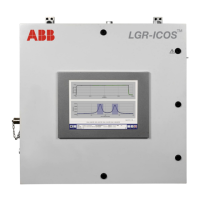GLA531 Series LGR-ICOS™ Gas Analyzer
Operating Manual
3KXG165002R4201_2021_04
ABB PROPRIETARY INFORMATION 69
• An alarm or warning for linelock (A) or (B) indicates an error with the linelock control mechanism:
Contact ABB Service for further instructions.
• The most common cause of losing the laser linelock is extreme operating temperature (very hot or very
cold). In this case, the abnormal temperature difference creates an outside-of-range condition for the
automatic self-correction.
• The second most common cause is abnormal gas pressure inside the ICOS cell.
• To remedy this situation, restore the operating condition to the normal temperature and pressure. Then,
follow the Laser Adjust procedure. Also, see Figure 26 and Figure 27 for the HMI screen reference.
• Refer to the correct screenshots of the spectrum in the installation document shipped with the analyzer.
• If you cannot find the correct wavelength, contact ABB Service for further instructions.
Laser Path-Length and Astigmatic Mirrors
Laser path-length inside the ICOS cell depends on the reflectivity of the astigmatic mirrors. Refer to the schematic
diagram in Figure 12 and the description in
ABB
’s OA-ICOS. Although the ICOS cell is protected by an inlet filter,
thin deposits of contaminants may accumulate on these mirrors over time, and the mirror reflectivity decreases.
Reduction in reflectivity directly affects the effective path length and therefore, instrument precision. The ring-
down time is the time constant for the light intensity to decay as it leaves the cavity.
• Laser power and mirror reflectivity issues are reported on the Alarm Status display (see Figure 19).
• An alarm or warning for Mirror Health (A) or (B) and/or Signal Power (A) or (B) indicate the mirrors have
been contaminated.
• Ring-down time is displayed on the user control-bar in micro-seconds for Laser A and Laser B. See
Figure 56 below for reference. When the reflectivity decay reaches 10% reduction from the original
value, a warning on Mirror Health is reported on the Alarm Status display (see Figure 19).
• When the mirror reflectivity (or ring-down time) decays more than 20%, an alarm on Mirror Health is
reported. It is highly advised to have the mirrors cleaned immediately. A significant reflectivity reduction
of more than 20% may affect the precision and reliability of the measurements. The mirror cleaning
supplies in the yearly maintenance kit are required to clean the mirrors.
WARNING!
Mirror cleaning must be performed by trained personnel who have successfully
completed the maintenance course on the analyzer.
Always follow the “Lockout-tagout” procedure when servicing the analyzer.

